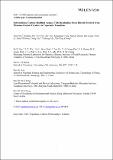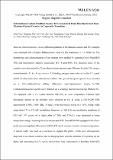Files in this item
Substitutional carbon‐modified anatase TiO2 decahedral plates directly derived from titanium oxalate crystals via topotactic transition
Item metadata
| dc.contributor.author | Niu, Ping | |
| dc.contributor.author | Wu, Tingting | |
| dc.contributor.author | Wen, Lei | |
| dc.contributor.author | Tan, Jun | |
| dc.contributor.author | Yang, Yongqiang | |
| dc.contributor.author | Zheng, Shijian | |
| dc.contributor.author | Liang, Yan | |
| dc.contributor.author | Li, Feng | |
| dc.contributor.author | Irvine, John T. S. | |
| dc.contributor.author | Liu, Gang | |
| dc.contributor.author | Ma, Xiuliang | |
| dc.contributor.author | Cheng, Hui-ming | |
| dc.date.accessioned | 2019-03-30T00:38:00Z | |
| dc.date.available | 2019-03-30T00:38:00Z | |
| dc.date.issued | 2018-05-17 | |
| dc.identifier | 252704584 | |
| dc.identifier | adf96643-ecd2-4c34-a349-cc7218109355 | |
| dc.identifier | 85044620013 | |
| dc.identifier | 000431961600007 | |
| dc.identifier.citation | Niu , P , Wu , T , Wen , L , Tan , J , Yang , Y , Zheng , S , Liang , Y , Li , F , Irvine , J T S , Liu , G , Ma , X & Cheng , H 2018 , ' Substitutional carbon‐modified anatase TiO 2 decahedral plates directly derived from titanium oxalate crystals via topotactic transition ' , Advanced Materials , vol. 30 , no. 20 , 1705999 . https://doi.org/10.1002/adma.201705999 | en |
| dc.identifier.issn | 0935-9648 | |
| dc.identifier.other | crossref: 10.1002/adma.201705999 | |
| dc.identifier.other | ORCID: /0000-0002-8394-3359/work/68280739 | |
| dc.identifier.uri | https://hdl.handle.net/10023/17402 | |
| dc.description | The authors thank the Major Basic Research Program, Ministry of Science and Technology of China (2014CB239401), National Science Fund of China (Grant Nos. 51422210, 21633009, 51561130157, and 51521091), and the Key Research Program of Frontier Sciences CAS (QYZDB‐SSW‐JSC039) for the financial support. G.L. is grateful for the award of a Newton Advanced Fellowship. | en |
| dc.description.abstract | Changing the composition and/or structure of some metal oxides at the atomic level can significantly improve their performance in different applications. Although many strategies have been developed, the introduction of heteroatoms, particularly anions to the internal part of metal oxide particles, is still not adequate. Here, an effective strategy is demonstrated for directly preparing polycrystalline decahedral plates of substitutional carbon‐doped anatase TiO2 from titanium (IV) oxalate by a thermally induced topotactic transition in an inert atmosphere. Because of the carbon concentration gradient introduced in side of the plates, the carbon‐doped TiO2 (TiO2–xCx) shows an increased visible light absorption and a two orders of magnitude higher electrical conductivity than pure TiO2. Consequently, it can be used as a photocatalyst and an active material for lithium storage and shows much superior activity in generating hydroxyl radicals under visible light and greatly increased electrical‐specific capacity at high charge–discharge rates. The strategy developed could also be applicable to the atomic‐scale modification of other metal oxides. | |
| dc.format.extent | 1620931 | |
| dc.format.extent | 1114898 | |
| dc.language.iso | eng | |
| dc.relation.ispartof | Advanced Materials | en |
| dc.subject | Carbon | en |
| dc.subject | Lithium | en |
| dc.subject | Photocatalysis | en |
| dc.subject | TiO2 | en |
| dc.subject | Topotactic transition | en |
| dc.subject | QD Chemistry | en |
| dc.subject | NDAS | en |
| dc.subject.lcc | QD | en |
| dc.title | Substitutional carbon‐modified anatase TiO2 decahedral plates directly derived from titanium oxalate crystals via topotactic transition | en |
| dc.type | Journal article | en |
| dc.contributor.institution | University of St Andrews. School of Chemistry | en |
| dc.contributor.institution | University of St Andrews. EaSTCHEM | en |
| dc.identifier.doi | 10.1002/adma.201705999 | |
| dc.description.status | Peer reviewed | en |
| dc.date.embargoedUntil | 2019-03-30 |
This item appears in the following Collection(s)
Items in the St Andrews Research Repository are protected by copyright, with all rights reserved, unless otherwise indicated.


